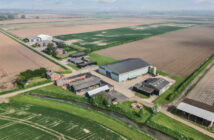In light of new water quality regulations, which will be introduced by Defra on 2 April 2018, farmers are being encouraged to consider the use of controlled release fertilisers (CRF) to help minimise nitrate leaching.
The new ‘farming rules for water’ are aimed at protecting water quality and have implications for soil nutrition and fertiliser use.
Dr Richard Collins, ICL technical sales manager, explains that nitrogen in water can become a major issue for water companies, as they have a responsibility to provide customers with safe drinking water, that meets the current nitrate standard of 50mg/l as NO3.
“To ensure this standard is not exceeded, water companies must implement costly and energy intensive treatment measures, and these added costs quickly push up the price to the customer.
“For this reason, farmers should look to follow the new Defra guidelines and explore how technologies such as CRFs can help in reducing leaching and run-off into surface and ground waters while maintaining the availability of nitrate fertilisers on the market,” he says.
Richard notes that many of the new rules are already being widely followed. But the April deadline provides a timely opportunity to review practices and consider the cost savings that come about through efficient fertiliser use and good soil management.
“CRFs could make a real difference in helping potato farmers to minimise nutrient leaching, which is a key aim of the new rulings.
“The technology is simple but effective. The fertiliser granules are coated with a semi-permeable layer that acts like a gateway. As the soil temperature increases, cracks open in line with the plant’s nutritional needs. But if the temperature drops, the cracks close and reduce the nutrient flow,” says Richard.
Recent independent trials, carried out by Lincolnshire based Barworth Agriculture, tested this theory and have proven that the use of CRFs can improve gross margins through yield increases.
“When compared to standard nitrogen applications, the trial results show significant increases in tuber numbers and total yield. But most importantly marketable yield, which when treated with Agromaster alone increased by 7t/ha, and 7.5t/ha when using Agrocote blended with a standard nitrogen fertiliser.
“So, working with a price of potatoes at £100/t and taking the cost of the CRF into account, the increase in gross margin would equate to between £350t/ha and £580t/ha, depending on the fertiliser used, which could make a significant difference to farm profitability,” says Richard.
He goes on to explain that careful planning of fertiliser applications is also a requirement of the new farming rules. “Using the right fertiliser blend for the field is key to productivity, and as stated in the rules, regular soil testing can help farmers to understand the specific crop requirements.
“While each field will have different needs, some potato crops will require a small amount of straight nitrogen just after emergence in addition to the base applications, in order to give the crop a boost. After this, a CRF that offers a gradual ‘drip-feed’ of nitrogen preferable throughout the growing season.
“Getting this balance right will ensure that nitrogen leaching is kept to a minimum. Too much fertiliser applied to a young crop will not only be lost from the soil, but it will also encourage inefficient and excessive leaf growth instead of tuber development,” explains Richard.
For more information on CRFs and the role that they can play in water protection, please visit the ICL website at icl-sf.com/uk/explore/fruit-vegetables-arable-crops/controlled-release-fertilizers/
The new farming rules for water include:
- Planning use of manures and fertilisers
- Storing organic manures
- Applying manures or fertilisers
- Where not to apply organic manures
- Where not to apply fertiliser
- Reasonable precautions to prevent soil erosion
- Protecting against soil erosion by livestock
- Position of livestock feeders




